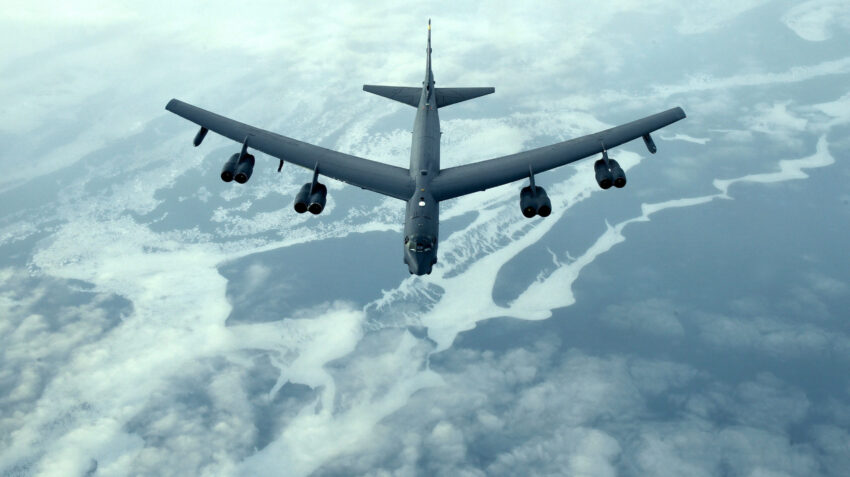A U.S. Air Force B-52H Stratofortress assigned to the 5th Bomb Wing at Minot Air Force Base, North Dakota, flies alongside a KC-10 Extender assigned to the 305th Air Mobility Wing, Joint Base McGuire-Dix-Lakehurst, N.J., after receiving fuel, Jan. 6, 2021. (U.S. Air Force photo by Staff Sgt. Stephanie Serrano)
WASHINGTON — The B-52 Stratofortress is now not expected to field an upgraded radar until as late as 2030, a delay of roughly three years, as officials struggle to modernize the Eisenhower-era bomber, according to a watchdog report.
The finding from the Government Accountability Office’s annual assessment of top Pentagon programs [PDF] comes after an Air Force official disclosed in May that the radar upgrade had suffered a cost breach. The effort, known as the B-52 Radar Modernization Program (RMP), has officially breached the program’s baseline schedule for both the beginning of production and initial operational capability, GAO says.
According to the report, the radar upgrade’s two-stage production decision, which the Pentagon’s weapons tester previously found had been delayed to the second and fourth quarters of FY26, has slid even further, and is now set for the fourth quarter of FY26 and the second quarter of FY27.
The radar’s estimated initial operational capability has been delayed too, out to mid-2030, the report says. GAO estimated last year that the aircraft’s initial operational capability, or in-service date, would be reached by mid-2027.
Officials told GAO that delays encountered so far stemmed from “challenges related to environmental qualification, parts procurement, and software,” the report says.
The report also found that even the delayed beginning of production “is at risk due to software challenges,” where the program has also experienced “lower-than-expected contractor performance.” GAO also pointed to potential issues with the production decision, such as supporting data limited to ground testing and some flight testing.
Boeing is the prime contractor for the effort and is integrating a radar supplied by RTX. Boeing referred a request for comment for this report to the Air Force, which did not immediately respond. RTX said in a statement to Breaking Defense that the company “is currently delivering advanced radars to Boeing under an engineering development contract that will ensure the B-52 fleet remains operational for decades to come. We are actively negotiating the production contract costs ahead of an anticipated award in 2026.”
Air Force officials have previously warned of rising costs and sliding timelines for the Boeing-led effort to modernize the bomber, which also includes a parallel program to upgrade the aircraft’s engines. Persistent issues with fielding the new sensor could explain an Air Force query to industry in March seeking alternative radar sources for the B-52, which was previously reported by The War Zone.
Alongside an engine upgrade, known as the Commercial Engine Replacement Program, the B-52 will be redesignated the B-52J, enabling the 76-strong bomber fleet to continue flying into the 2050s. The prolonged service of the B-52 will eventually lead to a two-bomber fleet for the Air Force, as B-1 and B-2 aircraft are retired and new B-21 Raider stealth bombers are acquired.
HACM ‘Rapid Fielding’
Meanwhile, amid apparent pressure from adversaries, the Air Force is also shifting course for the development of a hypersonic cruise missile, GAO found. The service is planning for “rapid fielding” of the Hypersonic Attack Cruise Missile (HACM) in early 2027, despite delays in the weapon’s schedule that are driving a compressed flight test plan.
Program officials told GAO that the Air Force now plans to acquire “a larger inventory of missiles sooner, while simultaneously improving the manufacturability of the design and expanding the capacity of the industrial base.” As part of the plan, officials are now ordering additional missiles beyond an ongoing rapid prototyping effort to keep the weapon’s production flowing, while refining its design until the beginning of the rapid fielding phase in 2027.
According to GAO, officials told the program office they were changing focus “from a prototype demonstration to a program that would deliver operational capability in fiscal year 2027” due to “global power competition and urgency to address threats.” (When the Air Force awarded the HACM contract to RTX in 2022, the service said that “a HACM capability with operational utility” would be delivered by fiscal 2027 — in part because the program is a rapid prototyping effort with a five-year timeframe.)
Despite the new fielding plan, GAO found the HACM program is “behind schedule,” and that officials are still working to establish a schedule baseline within the five-year rapid prototyping timeframe. Delays are limiting the window for flight testing, reducing the number of planned flights from seven to five. The flight testing itself, which was previously supposed to kick off in FY25, appears to be delayed, as GAO reports it beginning in calendar year 2026.
On top of schedule woes, the report says that RTX “is also projecting that it will significantly exceed its cost baseline,” which will at least be partially ameliorated by foregoing the two flight tests.
The Air Force plans the rapidly fielded HACMs will represent a minimum viable product, but one that will be “operationally relevant,” meaning the missiles will functionally be useful for combat.
Asked about the new plan for HACM, an Air Force spokesperson told Breaking Defense that the service “is not providing any additional information on this due to enhanced program security measures.” RTX declined to comment on HACM.
HACM is one of two Air Force hypersonic programs in the works, following the recent surprise move to revive a hypersonic boost-glide system known as the Air-launched Rapid Response Weapon (ARRW). The Trump administration’s budget would officially move ARRW into procurement, while also boosting funds for HACM.
Click this link for the original source of this article.
Author: Michael Marrow
This content is courtesy of, and owned and copyrighted by, https://breakingdefense.com and its author. This content is made available by use of the public RSS feed offered by the host site and is used for educational purposes only. If you are the author or represent the host site and would like this content removed now and in the future, please contact USSANews.com using the email address in the Contact page found in the website menu.








